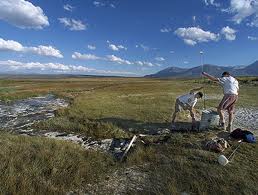Bear Creek Provides Update on Exploration Programs
Vancouver, B.C. – Bear Creek Mining (TSX Venture: BCM) (“Bear Creek” or the “Company”) is pleased to provide updates on its exploration programs in Peru. The Company maintains a cost effective generative exploration program alongside its primary focus of advancing the development of the Corani and Santa Ana silver deposits. The three projects described in this update range from an advanced Phase III drilling program at the La Yegua copper prospect to promising new results from our Maria Jose gold project.
Andrew Swarthout, President and CEO of Bear Creek, states “Bear Creek has a strong discovery history leading to value creation for shareholders and is fortunate to have the funding, experience and expertise to continue to explore for new discoveries during a time of great opportunity in the industry when exploration costs have come down and competition for good prospects has lessened substantially.”
Maria Jose Prospect – Maria Jose is located in the Department of Ancash, 140 kms NNW of Lima. The project is comprised of Cretaceous to Paleocene intrusives of the Coastal Batholith hosting a system of east-west to northeast trending, 45° to steeply north dipping, mesothermal quartz veins and shear zones containing high-grade gold grade – silver values. At surface, the five main east-west veins can be traced for a cumulative strike length of approximately 3 kilometers; however, shallow cover is prevalent in the district and the possibility of much longer strike lengths are being investigated by shallow trenching and sampling. The observed veins range in thickness from 0.20 meters to 4.5 meters with average true widths of approximately 1 meter.
Highlights of Maria Jose include:
- Vein intersections reach up to 4.5 meters with an average grade of 27.2 g/t gold;
- Systematic channel sampling performed on the Mari vein exposed 158 meters of strike with an average grade of 19 g/t gold over a true average width of 0.84 meters. The channel samples establish vertical continuity of gold mineralization over at least 220 meters; and
- Total veins length is approximately 3 km and extend under thin post-mineral cover.
Initial mapping and channel sampling (16 samples) of several veins yielded values ranging from 2.2 g/t to 233 g/t gold in the east-west trending vein system and from 4 g/t to 22 g/t gold in the northeast system over widths from 0.2 meters to 0.4 meters (see news release dated March 18, 2013). The full widths are being exposed and channel sampled in the ongoing field program.
Based upon preliminary field work to date, the mesothermal veins are consistently gold bearing and are indicated to have vertical continuity for at least 300 meters as evidenced by prospect pits and scattered outcrops separated by thin soil cover.
The field program commenced in second quarter of 2013 and included mapping and trenching in preparation for Phase I drilling and an underground exploration tunnel (50 m) anticipated to commence in mid-2014 pending the outcome of environmental permits. The goal of this program is to demonstrate the economic potential through drilling and underground exploration targeting the veins for grade continuity laterally and at depths up to 300 meters.
Under the option agreement with a private Peruvian third party, Bear Creek Mining may acquire 100% of Maria Jose (3,500 hectares) by making escalating payments totaling US$4 million over 4 years. The initial option payment of US$372,000 was paid on February 27, 2013 and the second payment of US$310,000 is due 18 months after; however, the second payment is contingent upon receiving necessary community agreements and permit approvals. Therefore, the Company has sufficient time to complete additional field work and initial drill testing to define the potential in advance of larger, balloon payments. An additional payment of US$2.6 million must be made if the deposit contains greater than 1 million ounces gold in resources as defined by a NI 43-101 technical report. There are no royalty provisions under the agreement.
La Yegua copper-gold-molybdenum project – The La Yegua copper-gold-molybdenum prospect is located in central Peru approximately 20 kilometers northeast of the Los Chancas copper-gold-molybdenum deposit in a prolific porphyry copper belt also containing the Las Bambas, Huaquira, Constancia, Tintaya and Antapaccay deposits.
In October 2010, Bear Creek entered into a joint venture agreement with Japan Oil, Gas and Metals National Corporation (“JOGMEC”) to advance the La Yegua Project to phase II drilling. The agreement provides for JOGMEC to earn a 51% interest through investing US$3 million over a three year period. JOGMEC has met its earn-in expenditures for acquisition of a 51% interest in the project. The Company will evaluate the current results in order to determine if Bear Creek will contribute its share of exploration expenditures in order to maintain its 49% interest. Alternatively, the Company can elect to dilute its interest until reaching 10%, at which time the Company’s interest will revert to a 1.0% NSR.
Phase II drill holes totaling 759 meters (three holes) were drilled at La Yegua from September 2011 through December 2011, where intercepts of up to 0.2% to 0.3% copper were encountered over intervals of up to 20 meters. The joint venture also completed additional geophysics in early 2011 that identified two high-chargeability anomalies defined by Induced Polarization/Resistivity (“IP”) surveys.
Phase III drilling commenced on May 22, 2013, and included 1,183 meters of drilling in three holes. This program tested part of the aforementioned two geophysical anomalies contacts, and returned values up to 0.3% copper over 150 meters. Recently, in February 2014, the Joint Venture finished a drilling campaign comprised of an additional three holes. The final drill hole intersected the best drill interval at the project (260 meters with 0.29% Cu and 45 ppm Mo) on the borders of a strong geophysical IP anomaly which remains untested and extends for 1.4 km x 600 m. Geological studies both inside and outside the main target / IP area will continue in order to identify additional possible drilling targets. Drilling will likely be reinitiated during 2014 depending upon obtaining required environmental permits.
Sumi copper-gold project – The Company acquired a 100% interest in the Sumi copper-gold prospect by staking in 2011. Sumi is comprised of 1,200 hectares located in the gold-silver tertiary-age epithermal belt in central Peru. The prospect exhibits alteration and mineralization typical of a volcanic-sediment hosted, high and low-sulfidation precious metals system with a copper-gold porphyry potential source. To date, 111 surface rock chip samples have been collected at Sumi. Assay results for the 111 samples have returned precious metal values including 15.65 g/t gold and 156 g/t silver in a vein-breccia structure over widths of 0.3 to 2.0 meters and 12.1 g/t gold and 102 g/t silver over 2 meter widths in a silicified volcano-sedimentary rock. Based upon favorable surface mapping and geochemical sampling, a phase I drilling program was performed in the fourth quarter of 2012 consisting of five diamond drill holes totaling 1,105.3 meters (see the Company’s news release dated March 13, 2013). Highlights of the results are:
- Drill hole SU-5 returns 17 meters averaging 3.6 g/t Au and 3.2 g/t Ag from 50.65 to 68 meters depth;
- Drill hole SU-2 returns 50 meters averaging 0.98 g/t Au and 5.1 g/t Ag from 124 to 174 meters depth;
- Drill hole SU-1 returns 10 meters averaging 4.4 g/t Au from 69.9 to 80 meters depth; and
- Three cyanide extraction bottle roll tests on drill core ground to 85% passing minus 200 mesh averaged 86.6% gold recovery; two tests on higher sulfide content samples yielded less than 40% recoveries.
In March 2014, Bear Creek entered into a joint venture agreement with Japan Oil, Gas and Metals National Corporation (“JOGMEC”) to advance phase II drilling to test additional blind vein-breccia targets plus a possible buried Cu porphyry source underlying the large epithermal mineralization footprint exposed at the surface. The agreement provides for JOGMEC to earn a 51% interest through investing US$2.5 million over a three year period. After March 2017, Bear Creek can elect to maintain its 49% interest or to dilute until reaching 10%, at which time the Company’s interest will revert to a 1.0% NSR.
Carito Gold prospect – In March 2014, Bear Creek completed a drilling campaign at its Carito gold project (6 holes / 1,428 m total). Drilling encountered low gold grades in several meters but due to surface enrichment and the low gold values encountered, Bear Creek has elected to not spend any additional money on the project and will seek a joint venture partner or terminate its option agreement.
Consistent with the Company’s aggressive generative exploration philosophy, several additional prospects in the portfolio are being evaluated for future drilling or acquisition.
View La Yegua Drill Results in PDF Format
Neither the TSX Venture Exchange nor its Regulations Services Provider (as that term is defined in the policies of the TSX Ventrue Exchange) accepts responsibility for the adequacy or accuracy of this release.
Andrew Swarthout – CEO, or Lisa May – Investor Relations
Phone: 604-685-6269 Direct: 604-628-1111
E-mail: info@bearcreekmining.com
For further information, please visit the Company’s website (www.bearcreekmining.com)






